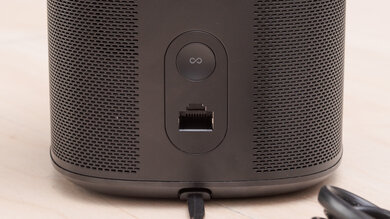The Samsung HW-Q90R is a great soundbar that's versatile for a wide variety of uses and it's one of our best performing soundbars so far. It has a great overall audio reproduction, has a fairly wide and very focused soundstage, and it'll perform very well with pretty much all types of content. This 7.1.4 setup provides an immersive listening experience on supported content thanks to Atmos. It also offers plenty of connection options, both wired and wirelessly. The setup is well-built and feels high-end. If you're looking for a premium setup that has great performance and can get loud regardless of the content you're listening to, the Samsung HW-Q90R is a great option.
Our Verdict
Great for mixed usage. The Samsung HW-Q90R soundbar has a very good, neutral, and accurate sound profile. It will perform well with all sorts of content such as dialogue, a wide variety of music genres, and movies. You can also get an immersive listening experience since it supports Atmos on its 7.1.4 setup. This soundbar performs well even at very high volumes, and it offers decent manual sound customization, but lacks a room correction feature.
- Great audio reproduction.
- Multiple connection options.
- Great performance at high volume.
- Supports Atmos and height channels for immersive experience.
- Small interface screen.
- Very wide bar.
- No room correction.
Great for dialogue and watching TV shows. The Samsung HW-Q90R soundbar is also great for podcasts and audiobooks. It sounds neutral and the overall reproduction of voices is accurate. It gets very loud and has a feature to make dialogue clearer at low volumes too. You can also easily stream audio content from your phone to the bar.
Great for music. The Samsung HW-Q90R soundbar setup has an accurate and neutral sound profile which is suitable for a wide variety of music genres. It also has a good soundstage size and is also focused. This setup can get very loud and doesn't compress, even at higher volumes, which is great. You can easily EQ this setup and set the level of the subwoofer separately, to your liking.
Great for movies. The Samsung HW-Q90R soundbar sounds great and also supports Atmos, which gives you a more immersive experience when compared to some other soundbars. However, it won't sound as real as a setup with down-firing speakers. You'll still be able to play surround sound content with a good sound quality. There are also a few features to customize the sound to your liking, and you can easily set the amount of bass you want from the sub.
Changelog
- Updated Dec 22, 2021: Added third-party voice assistant support.
- Updated Mar 29, 2021: Added information about the sub not connecting to the bar during our testing.
- Updated Mar 29, 2021: Converted to Test Bench 1.0.
- Updated Sep 04, 2020: Sound Enhancement Features has been updated to reflect this soundbar's EQ presets.
Check Price
Popular Soundbar Comparisons
The Samsung HW-Q90R is one of the best performing soundbars we've tested so far. It's very versatile for every type of content you play and performs great overall. It's a high-end model that looks and feels premium and supports Atmos for an immersive experience with movies. See our recommendations for the best soundbars, the best Dolby Atmos soundbars, and the best soundbars for music.
The Samsung HW-Q90R is basically the Samsung HW-Q80R, but with rear satellites that have up firing speakers. They both perform quite similarly, but the Q90R has a small edge over the Q80R. The 7.1.4 Q90R has a better overall surrounds performance thanks to the rear speakers, which is the main difference. Both bars are very similar and your choice will come down to personal budget and preference of content.
The Samsung HW-Q90R is a better soundbar setup than the Samsung HW-Q70R. The Q90R is an Atmos-enabled 7.1.4 setup with dedicated rear satellites, while the Q70R is a 3.1.2 setup that consists of just the soundbar and a wireless subwoofer. The Q90R has a wider soundstage, and better surround performance thanks to its dedicated satellites. On the other hand, the Q70R is a slightly more compact setup with a smaller bar and less separate pieces.
The Samsung HW-Q90R is a better soundbar than the Sonos Arc. The Samsung is a 7.1.4 setup with a more neutral sound profile and better performance at max volume. It also has a better surround performance and has a graphic EQ and presets to customize its sound. However, if you already have Sonos speakers, the Sonos app is very useful and allows you to control your ecosystem, which is nice. Also, the Sonos can be upgraded to the Sonos Arc with Sub + One SL Speakers for better performance.
The Samsung HW-Q90R is a better soundbar system than the Sennheiser AMBEO Soundbar MAX. The Sennheiser is a system that tries to do it all with only a stand-alone bar but doesn't quite excellent at being versatile like the Samsung soundbar does. The stereo audio quality of the Samsung is noticeably better, just like the Atmos performance, thanks to the up-firing speakers on the bar and the satellites. On the other hand, the surround AMBEO mode of the Sennheiser soundbar is quite impressive for a stand-alone bar and adds to the immersive listening experience.
Test Results


































